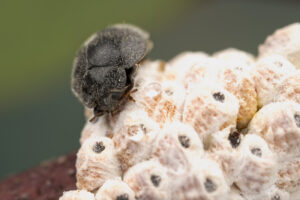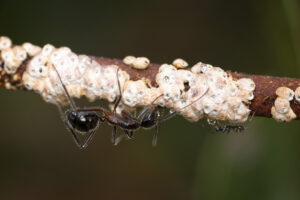
Ants abound, but is that bad?
By Denis Crawford
Many ants are beneficial, but some ant species can be pests in some situations. When is that?
This Pest Files is inspired by some recent encounters I had with ants. In late January 2023 I noticed several species of ants climbing the trunk of a young roadside gumtree (Eucalyptus obliqua). To me that was a sure sign there were sap-sucking insects somewhere up in the tree. Many species of ants are drawn to the honeydew (excess phloem sap sugars) that is excreted by sap-sucking insects.
As I looked closer, I could see colonies of gumtree scale insects encrusting some of the twigs and branches of the tree. I could also see honeydew on the upper surface of some leaves. Gumtree scales (Eriococcus spp.) are common on a variety of eucalypt species, and the scales are well-known for producing vast amounts of honeydew.

Several species of ants of various sizes from tiny ants to bull ants, as well as several fly species, were feeding on the honeydew. Some clusters of gumtree scale were producing so much honeydew that you could clearly see it raining down on the leaves below, where ants were feeding on it. For those that are interested, you can see all of this in a video I made for my ‘one minute bugs’ YouTube channel, entitled “Raining sugar”. Sooty mould can grow on the honeydew on leaves and the mould was evident on some leaves.
In a natural system such as this the gumtree is native, the gumtree scale is native, as are the ant and fly species, therefore none of them are pests. On a feature tree in a cultivated situation it is a different story. For example, some gumtrees such as Eucalyptus caesia ‘Silver Princess’ are particularly susceptible to gumtree scale insects, so in that situation the scale insects are definitely pests but what about the ants?
The literature, including many articles I have written, will tell you that ants protect sap-sucking insects from predators and parasites in return for a feed of honeydew. In the case of our roadside tree this aspect of the story gets interesting. Right under the antennae of the ants were larvae of the gumtree scale ladybird (Rhyzobius ventralis). The ladybird larvae have a couple of ways of protecting themselves. When ants are nearby the ladybird larvae remain perfectly still until the ants move off, and only then do the larvae move. In this stop-start manner the ladybird larvae can move safely away from ants. If the ladybird larvae are attacked by ants and bitten, they release a red fluid from abdominal glands that is repugnant to ants. Adult gumtree scale ladybirds are very active and are easily able to avoid ants by flying away if they need to.

What this means is that predators can find a way to get to the insects they want to feed on, and not all of them are driven away by the ants. In other words, the sap-sucking insects don’t have total protection. I have seen a similar thing happen with parasitic wasps. Various ant species attend lerp-forming psyllids on gum trees because of the honeydew they excrete. I have seen a tiny parasitic wasp (Psyllaephagus sp.) waiting for ants to turn their backs and then darting in and laying eggs into psyllids underneath their lerps.
Getting back to gumtree scales, I examined a heavily infested ‘Silver Princess’ next to a house on a nearby local property. I noticed there were very few gumtree scale ladybirds present to combat the scale infestation. The tree was also covered with hordes of honeydew-feeding ants which trooped across the verandah and were becoming a nuisance to the owners. In that situation the ants had to be controlled, as well as the gumtree scale infestation being oil-sprayed.
Ants are also attracted into various plants by the plants’ extrafloral nectaries. An example I am familiar with is the extrafloral nectaries of cherry trees. The nectaries attract several species of ants, including sugar ants and meat ants, into my own cherry tree. The tree is routinely targeted by pear and cherry slugs (Caliroa cerasi), and I can assure you that the ants do very little to keep the pear and cherry slugs from feeding on the leaves. If I don’t take action (dusting the tree with wood ash) the tree would be defoliated. The extrafloral nectaries on peony buds attract ants and this is used in science textbooks as an example of biological mutualism. In other words, the plants give sweet fluid to the ants in return for protection from flower-feeding insects. I wonder just how effective the ants are at doing that.

Some ant species are definitely pests. Back in July 2017 I wrote about invasive ants, and the species that is most relevant here is the Argentine ant (Linepithema humile). These ants are very small, about 3 mm long, and can build up into colonies of thousands. Outdoors, they prefer to feed on the honeydew produced by sap-sucking insects such as aphids. Consequently, large numbers of ants may stream up into trees and shrubs that are afflicted by pest aphids, and drive away many of the aphid predators and parasites, which results in an increase in the aphid population. This can be easily solved by banding the trunk of the plant with horticultural glue to prevent the ants climbing into it. After that, it’s just a matter of finding the nest and destroying it.
Getting back to the ants on our roadside tree, some of the ant species involved such as bull ants (Myrmecia spp.) are omnivorous, so they are predators and scavengers as well as nectar collectors. Other common ants such as meat ants (Iridomyrmex spp.) are similar in habits. In other words, ants don’t protect sap-sucking insects all the time and they are beneficial at other times. If ants are protecting sap-sucking insects on some plants, just keep them out of those plants.
There are about 1500 species of ants described so far in Australia, and the final number may be at least double that. Apart from the invasive pest species such as the Argentine ant mentioned earlier, ants are ecologically beneficial. They are among the leading predators of other insects, the ground-nesting species move almost as much soil as earthworms, and ants are vital for the seed dispersal of many species of plants. To quote one entomological website “It is hard to imagine any other insect or animal that has a more important and positive impact on the terrestrial environment that sustains us.”
Denis Crawford
Author: Gardens, Pests, Diseases & Good Bugs
M: 0417 117 741
W: youtube.com/c/oneminutebugs
Main photo: Gumtree scale excreting honeydew (Supplied by Denis Crawford of Graphic Science)
